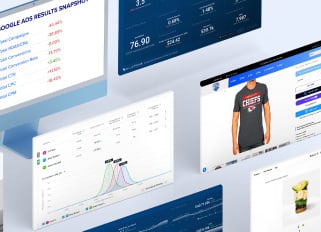
Shopify URLs: How to Optimize for SEO and User Experience
When it comes to running a successful Shopify store, your website’s URLs might not be the first thing that comes to mind. However, they play a surprisingly vital role in determining your site's SEO performance and the overall user experience (UX). A well-structured Shopify store URL can make it easier for both search engines and customers to understand your site, boosting visibility and usability.
This blog will guide you through everything you need to know about Shopify URLs, how they impact SEO and user experience, and actionable tips to optimize them for success. By the end, you'll have a clear path to better organize your Shopify store and improve your online performance.
Understanding Shopify URLs
Before jumping into optimization strategies, it’s essential to understand how Shopify generates URLs and what their structure looks like.
How Does Shopify Generate URLs?
Shopify automatically creates URLs for your store based on the type of page you’re creating. For example:
- Homepage - mystore.com
- Product page - mystore.com/products/product-name
- Collection page - mystore.com/collections/collection-name
- Blog post - mystore.com/blogs/blog-name/post-title
- Page - mystore.com/pages/page-title
As you can see, Shopify follows a logical structure. It uses the main domain followed by relevant keywords that describe the specific page. This helps both search engines and users understand what the page is about. Additionally, Shopify allows you to customize your URLs for each page manually.

Limitations Of Shopify URLs
Shopify's URL structure, while functional, comes with several limitations that may pose challenges for store owners aiming for a highly customized or SEO-friendly site organization. These include:
- Rigid Predefined Structure: Pages, products, and collections are locked into specific folders such as /pages/, /products/, and /collections/, which restricts the ability to create a flexible URL hierarchy that accurately mirrors the site’s taxonomy.
- No Sub-categories: Shopify does not support sub-categories in its URLs. For instance, you cannot create a URL like /clothing/shirts/blue-t-shirt, which would better represent the content organization; instead, you are limited to a flat structure like /collections/shirts or /products/blue-t-shirt.
- Duplicate Product URLs: Shopify generates URLs based on the product name, which can lead to duplicate URLs if you have multiple products with the same name. This can negatively impact SEO and user experience.
- Character Limitations: Shopify URLs are limited to 255 characters. While this may seem like a lot, it can become restrictive when you have longer product names or blog post titles.
- Automatic Sitemap: Shopify restricts customization by generating an automatic sitemap that includes all pages indiscriminately, even those that store owners may prefer not to index, such as archives or duplicated pages
- Fixed URL Slugs: Shopify limits the customization of URL slugs, preventing them from effectively illustrating the site's hierarchy. This can impact user experience and search engine clarity.
Impact Of URLs On SEO And User Experience
Now that we understand how Shopify generates URLs and their limitations, let's explore why they matter for the success of your brand and online store.
SEO Performance
URLs play a significant role in search engine optimization. Search engines like Google use them to understand the content of a page and determine its relevance to user queries.
A well-crafted URL that includes relevant keywords and accurately reflects the page's content can help improve your site's visibility on search engine result pages (SERPs). Additionally, a clear and concise URL is more likely to be clicked on by users, which can improve your click-through rate (CTR).
Pro Tip: Use Google Search Console's URL inspection tool to check how Google views and indexes your URLs.
User Experience
URLs also play a crucial role in your store's overall user experience. A well-structured URL makes it easier for potential customers to navigate your site and quickly find the information they need. Long, confusing, or irrelevant URLs can make it difficult for users to understand where they are on your site and may discourage them from exploring further.
Additionally, customizable URLs can help create a better visual hierarchy and organization of your site's content, making it more user-friendly. They can also help customers remember and share specific pages, especially if the URL includes relevant keywords or a compelling call-to-action.
Link Building
Lastly, URLs also play a crucial role in your link-building strategy. When other websites link back to your site, they often use the URL as the anchor text, especially if no specific text is provided. This means having a well-structured, readable, and relevant URL is essential, as it can directly influence how search engines perceive the linked content.
Best Practices for Optimizing Shopify URLs
Now that you understand the basics of Shopify URLs, let’s dive into some actionable tips to optimize them for SEO.
1. Keep Them Simple And Relevant
Your URL should clearly and concisely represent the page content. This means avoiding unnecessary characters or numbers and focusing on relevant keywords. For example, instead of “mystore.com/product12345,” use “mystore.com/silk-blue-dress.” This helps with SEO and makes it easier for users to remember and share your URLs.
2. Use Hyphens Instead Of Underscores
When creating URLs, it's important to use hyphens (`-`) instead of underscores (`_`) to separate words. Search engines recognize hyphens as word separators, which helps improve readability for both users and search engines. On the other hand, underscores don’t work the same way and can make it harder for search engines to interpret your URL.
For example:
- Good URL: `/collections/summer-sale` (clear and easy to read)
- Bad URL: `/collections/summer_sale` (less readable for search engines and users)
 3. Customize Your URL Slugs
3. Customize Your URL Slugs
Shopify allows you to customize the final part of your URL, also known as the URL slug. This can help create a clean, organized URL structure that accurately reflects your site's taxonomy.
When creating custom slugs, follow the same best practices mentioned above - keep them simple and relevant, and use hyphens instead of underscores. Additionally, make sure that each URL slug is unique to avoid any duplicate content issues.
Pro Tip: You can customize the URL slugs for your pages, products, and blog posts in the Shopify admin panel under "Search engine listing preview."
 4. Avoid Duplicate URLs
4. Avoid Duplicate URLs
As mentioned earlier, Shopify automatically generates URLs based on the product name, which can lead to duplicate URLs if you have multiple products with the same name. This can negatively impact SEO and user experience as search engines may see it as duplicate content and choose one version to display on SERPs. To avoid this issue, make sure each of your product names is unique or add modifiers like color or size to differentiate them.
Additionally, if you have multiple pages or blog posts with similar content, make sure to use canonical tags to indicate the preferred URL and prevent duplicate content issues.
5. Manage Product Tags And Collections
Shopify also generates URLs based on product tags and collections. This means it's crucial to properly manage and organize your product tags and collections for SEO purposes. Avoid using generic or irrelevant tags that can create unnecessary URLs that don't add value to your site.
Pro Tip: Use Google Analytics to track user purchase behavior and identify which products and collections are most popular among customers. This data can help you optimize your product tag strategy and improve overall SEO performance.
6. Set Up 301 Redirects for Old Links
When you update an existing product or collection URL, ensure you create 301 redirects for the old page. This practice prevents users from landing on broken links when they click outdated URLs and retains your SEO rankings.
To set up a redirect in Shopify:
- Navigate to Online Store > Navigation > URL Redirects.
- Input the old entire URL and the new URL.
- Click Add Redirect.
Tools for Managing and Analyzing Shopify URLs
Optimizing Shopify URLs doesn’t have to be complicated. Several tools can help streamline the process and monitor URL performance.
- Shopify's Built-in URL Editor: Shopify makes it easy to edit page URLs directly in the settings menu. Navigate to the specific product, collection, or page, and update the "URL and Handle" field.
- Google Search Console: A great free tool for monitoring the performance of your Shopify URLs in search rankings. Use it to check for indexing issues, broken links, and keyword performance.
- Ahrefs or SEMrush: These premium SEO tools provide insights into your URL structure's impact on SEO. Analyze metrics such as traffic, backlinks, and keyword rankings for your Shopify URLs.
- Screaming Frog SEO Spider: This tool is ideal for auditing your Shopify store’s URLs. Crawling your site can pinpoint broken links, redirects, or duplicate content.
 FAQs
FAQs
What is the address bar, and why is it important for my Shopify store?
The address bar is a key component of any web browser, allowing users to enter or view a website's URL. For Shopify stores, optimizing the URLs displayed in the address bar is essential for improving both user experience and search engine visibility. To achieve better results, ensure your URLs are clear, concise, and enriched with relevant keywords.
What is a primary domain, and how can I set it up in my Shopify account?
A primary domain is the main web address customers use to access your Shopify store. You can set it up by navigating to the Shopify Dashboard, going to "Settings" > "Domains," and selecting the domain you'd like to use as the primary. Using a custom domain instead of the default Shopify URL can help establish credibility and trust with your audience.
How do I manage URLs in my Shopify dashboard?
The Shopify Dashboard allows you to manage your store's URLs efficiently. You can edit product, collection, or page URLs under their respective sections. Always ensure that your URLs align with your SEO strategy and maintain a logical structure for easier navigation.
What is a default URL, and should I change it?
A default URL is the automatically generated web address provided by Shopify when you first create your store. For example, it might look like `yourstore.myshopify.com`. While functional, replacing the default URL with a custom domain is recommended for branding and professionalism.
Can changing my web address affect my store's SEO?
Yes, changing your web address or URL structure can impact your Shopify store's SEO. To minimize disruptions, ensure proper 301 redirects are in place to guide both users and search engines from old URLs to new ones, preserving your rankings and user experience.
Turn Your Shopify Store into an SEO Powerhouse
Optimizing URLs is just one step in a holistic SEO strategy. As you build a strong foundation with Shopify, incorporate other techniques to boost your store’s authority and visibility. With consistent effort, your URL structure will help pave the way for better rankings and more traffic over time.
Keep in mind that these are general guidelines and may not apply to every situation. It's always best to continually monitor and adjust your URL strategy based on the needs and goals of your specific business. With a well-structured, SEO-friendly URL strategy, you can turn your Shopify store into an SEO powerhouse and attract more customers to your online business.
Get Expert Help from BlueTuskr
Struggling to optimize your Shopify store for SEO success? BlueTuskr's team of experienced professionals can help you craft a custom URL structure and implement proven strategies to drive more traffic, increase rankings, and boost sales. Contact BlueTuskr today for expert guidance and tailored solutions to take your Shopify store to the next level!
Connect With Us
Recent Post

.png)





Tell us what you think!